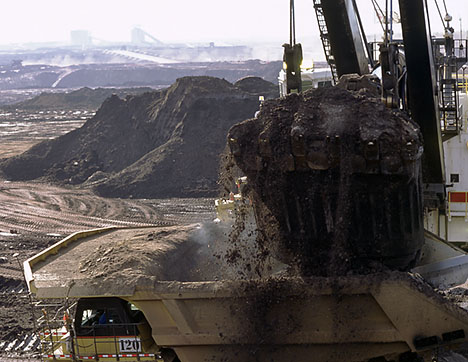 Last month, a ground-breaking study by Oil Change and other NGO’s calculated that Shell was the world’s most carbon intensive oil company, per barrel of oil equivalent to be produced. The main reason for this is its massive expansion into Canada’s climate intensive dirty oil sands.
Last month, a ground-breaking study by Oil Change and other NGO’s calculated that Shell was the world’s most carbon intensive oil company, per barrel of oil equivalent to be produced. The main reason for this is its massive expansion into Canada’s climate intensive dirty oil sands.
The report looked at the carbon intensity of the total resources of the four largest international oil companies – Shell, BP, Exxon and Chevron – and found that Shell was the worst.
Even this exercise was difficult due to the lack of reporting on data by the companies. Now a new analysis of climate risk disclosure by fossil fuel companies published by Ceres and the Environmental Defence Fund backs up this analysis. It paints a fascinating picture of the lack of information given by companies to investors about the climate risk of their operations. Shell gets heavily criticised, although is no means the worst.
The report noted that “Royal Dutch Shell’s disclosure of the significant climate risks it faces from its investments, particularly those in non-conventional fuels, did not provide the range of information needed by investors as outlined in the Global Framework.”
The report concludes with the Oil Change briefing paper that both Shell’s tar sands and oil shale investments are problematic. “Because of the substantial greenhouse gas emissions from tar sands and their contribution to global warming, their development presents a considerable climate risk to Shell and its shareholders.”
CERES and EDF note that Shell states, “As easy-to-access oil gets rarer, unconventional resources such as Canada’s oil sands will become increasingly important sources of energy.”
They argue that “This disclosure did not fully address the concern that tar sands development will release extensive quantities of greenhouse gases. Shell did disclose information on how it plans to make oil sands mining compatible with Shell’s emissions reductions efforts … Shell’s disclosure of information on unconventional fuels failed to provide clear, comprehensive information that investors can use to judge Shell’s exposure to and management of climate risks.”
Essentially Shell is trying to square a circle with oil sands – it knows that its business survival depends on reducing carbon emissions. But its business strategy is to exploit tar sands that have a much higher carbon intensity and hence higher emissions. So it knows it has to lower emissions, but has chosen to exploit a technology with high emissions. If it doesn’t make sense to you it doesn’t make much sense to Shell either, but still the company is doing it, with the panacea that CCS technology will somehow sort the problem out. If CCS does not work, or governments introduce tight climate standards, Shell is up the proverbial creek, with its whole business strategy in ruins.
Its not just tar sands Shell has a problem with either. The report notes “Shell is also actively engaged in securing government leases in the Western U.S. for development of oil shale, another unconventional oil resource. Oil shale development shares tar sands’ high greenhouse gas intensity, and also requires significant water resources. In its 10-K annual filing, Shell did not address how its oil shale investment fits within plans to mitigate global warming pollution.”
The climate stakes are just too high for Shell to “not address” these issues. But even if we think Shell is bad, its not the worst. Although it criticised Shell, the report said that “the company had the best climate risk disclosure” of all the oil and gas companies, “indicating the low level of disclosure in this sector.”
This is a situation that should not be allowed to continue by the regulatory authorities on both sides of the Atlantic.
